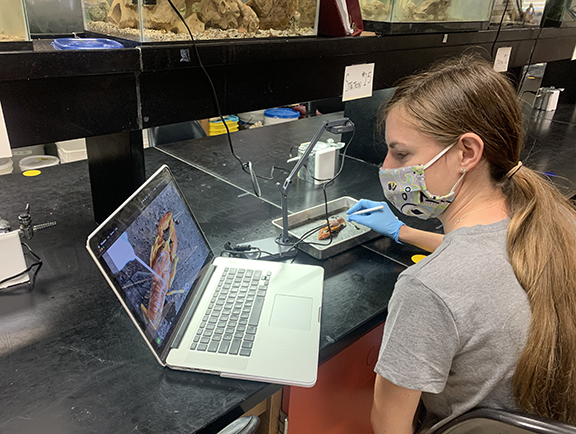"The biggest accommodation I would request is just a little bit of patience here. I need a little bit of patience to learn the system and work out all the kinks and quirks." —White male in his 30s who became visually impaired in childhood
Accessibility and Usability of Newly Adopted Technology
Participants were asked if their employer adopted and introduced new hardware or software to employees that was not accessible or usable for them. Half of the 297 participants (n=149, 50.2%) reported that they had experienced this situation. When asked about the policies and procedures their employer had in place when new software, tools, or apps were being adopted for employee use, 292 participants reported the following:
- There are policies and processes that take into consideration the needs of employees who use accommodations. (n=130, 44.5%)
- They were not sure if there are policies and processes that take into consideration the needs of employees who use accommodations. (n=75, 25.7%)
- There are no policies and processes that take into consideration the needs of employees who use accommodations. (n=45, 15.4%)
- There are processes that take into consideration the needs of employees who need accommodations, but they don’t result in protecting our interests (n=42, 14.4%)
Participants were asked to select their level of agreement with the statement: When adopting new software, tools, or apps, my current employer or contractor takes into consideration the accessibility and usability needs of those with visual impairments. Of the 299 participants who responded, 150 (50.2%) agreed or strongly agreed with this statement indicating that about half of the participants believed their employer took their needs for accessibility and usability into consideration while half did not.
Training on Newly Adopted Technology
"[I had to take a] virtual certification exam [on a new tool]…The exam I chose to take from home thinking this would be less travel and I can use my own equipment. The exam was conducted by a proctor of a third party that observes you via webcam. [So that I could be monitored via webcam] I had to take out all my large monitors and take the test via my laptop…I have to really have my face close to the laptop screen and when I have to move my head to look at the remaining time at the right edge of the screen (in small font) the proctor would warn me about keeping my head still. Then after doing this twice, he said next time, he will have to forfeit and cancel the test because it is against policy to move your head…Fortunately I passed the test but the whole point of taking [the] test at home was to accommodate for my vision [impairment] — which backfired." —Native American/Pacific Islander female in her 40s who is congenitally visually impaired
When a new technology is adopted in the workplace, assistive technology users may need training that directly facilitates the use of the new tool with their assistive technology. Participants were asked what they experienced as assistive technology users when their employer introduced new technology tools. Eighty (38%) of 208 participants reported they had no issues when new technology was introduced. The other 154 participants reported that:
- The employer provides timely and effective training; however, participants experienced periodic challenges as software is updated or other changes are made. (n=52, 25.0%)
- The employers’ training is not timely; therefore, employee productivity is impacted because the new tools or technology are not compatible with employees’ AT. (n=25, 12.0%)
- The employer provides timely training, but it is not effective for the type of accommodations employees need. This may impact how others perceive employees who use AT and/or employee productivity. (n=18, 8.7%)
- The employers’ training is not timely; therefore, others may perceive employees who use AT are not capable because the new tools or technology are not compatible with their AT. (n=16, 7.7%)
"Mostly, it was the wording that the presenter or instructor would use. For example, they would say, ’Click this blue icon,’ or ‘Move your mouse over here.’ I would’ve benefited from something saying, ’Click the blue icon that says ‘Submit’.’ Also, if the person could identify whether it was a link, a button, a radio button, etc. and use a combination of blind and sighted verbiage. Plus, the pace was VERY FAST, and I became frustrated because of not being able to quickly navigate with JAWS and to know what I’m looking for. I finally decided that I needed more one-on-one training but would always forget to ask for it because something else would come up that demanded my immediate attention." —White female in her 30s who is congenitally visually impaired
Participants were asked about their experience when their employer adopted new technology that required that employees be trained in its use. Of the 285 participants who answered this question, forty-six were not faced with a situation in which their employer adopted new technology while they were employed, while forty-two reported that their employer did not require them to complete training that wasn’t accessible. The remaining 197 of 285 participants selected one or more ways in which they were able to get training on the new technology. They reported they were:
- Required to complete the same training as other employees without being provided accommodations (n=156)
- Provided training that their employer worked to make accessible to them (n=118)
- Able to use online search (e.g., Google) to learn the information (n=114)
- Able to use sighted assistance to complete the training (n=108)
- Provided accessible training (n=107)
- Able to learn the information from other employees who may or may not use assistive technology (n=98)
- Able to gather information from talking to others who are visually impaired (n=98)
- Able to learn the information through watching videos (n=69)
- Able to use a visual interpreting service to complete the training (n=35)
Employer-Required Training
Most employers require employees to complete some type of training, whether it is compliance training such as sexual harassment, training on new proprietary products, or training focused on policies or procedures employees must follow. In a typical year, an employee may be required to complete online training that is self-paced and consists of the presentation of content delivered through slides, text, photos, and/or videos followed by test questions. Group in-person training may take the form of providing attendees with documents, a speaker giving a presentation, or hands-on activities attendees must complete to demonstrate competence in the subject matter.
Online Training
"The entire online module is not screen reader accessible. It is impossible to access the controls on the page to advance forward or back. The multimedia player is not accessible, and the videos are not described. The only way to complete this training was to have a human reader voice the information, which, in most cases, meant a colleague. So much for anonymity." —White male in his 50s who is congenitally visually impaired
Just over three fourths of the 323 participants (n=253, 78.3%) reported they were required to complete online training.
Participants were asked to select their level of agreement with the statement: The majority of online training I am required to complete is accessible to me as a person with a visual impairment. Of the 252 participants who responded, 152 (60.3%) agreed or strongly agreed with this statement, yet 25% disagreed or strongly disagreed that online training was ac-cessible. (14% neither agreed nor disagreed).
In an open-ended question, participants were asked to explain what aspects of the online training were not accessible to them. Of the 95 responses, 63 participants reported frustrations with being forced to complete mandatory trainings that were built either solely for people with typical vision, or with accessibility features added as an afterthought. Even when added, these features quite frequently did not work. Trainings were not accessible with JAWS or other screen reader software (n=51), or participants were unable to use their typical accommodations such as changing color, contrast, or magnification (n=7). Other participants described interactive quizzes and other elements that only worked with a mouse, not with keyboard commands, or pictures and videos containing no text or audio descriptions. Some participants stated that they could not complete the online training without assistance from sighted colleagues.
In-Person Training
"[For] the presentation (PowerPoint), physical handouts and the books for the class, I try to request these materials before the class, but I receive a lot of problems from the instructor. I have even been accused of wanting the materials so that I could post them to the Internet thus taking money from the pockets of the instructor." —Individual in their 50s
There were 215 (67.4%) of 319 participants who reported they were required to complete in-person training.
Participants were asked to select their level of agreement with the statement: Most of the training with other employees I am required to attend is accessible to me as a person with a visual impairment. Of the 217 participants who responded, 132 (60.8%) agreed or strongly agreed with this statement, similar to the data reported for online training.
In an open-ended question, participants were asked to explain what aspects of the online training were not accessible to them. PowerPoint presentations were the most cited inaccessible aspect of training due to the visual display of the slides, lack of description of visual description of the slides, and not being given materials ahead of time to preview and/or follow along with on one’s own device. Participants also described a lack of alternative text on images or videos in addition to other aspects of the online training materials, such as labeled buttons. While PowerPoint presentations can be accessible, they must be prepared to include attributes such as alternative text for images and use of high-contrast colors.
Impact of Inaccessible Training
Participants were asked to describe how training that was not fully accessible impacted their productivity or job performance. Impacts included participants feeling that their productivity was negatively affected and that completing tasks or figuring out training was incredibly time consuming. Participants reported frustration, feeling intimidated, and experiencing higher levels of stress as a result of being required to complete training that was not accessible to them.
Lack of accessible training also can affect employees’ relationships with others in the workplace. This particular survey question yielded a mix of responses with some participants reporting positive interactions, some reporting no impact, and some reporting negative impacts. The negative impacts seemed to be reported slightly more often and included being unable to engage or connect with others, feeling like a burden, experiencing dismissive or unhelpful attitudes, and even compromised privacy.
As with other components of employment, employers are obligated to provide accommodations and otherwise ensure accessibility in all types of workplace trainings. In an open-ended question, participants were asked how employers can improve training opportunities to make them more accessible to those who require accommodations. Overall, it seems the participants would like employers to be thoughtful before trainings occur. They urge employers to consider how to make materials more accessible, to consider the needs of employees who use accommodations when purchasing and using training platforms, and to educate themselves and other colleagues on accessibility matters.

